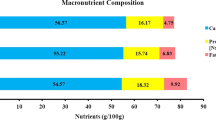Abstract
The chemical composition and protein quality of two varieties of buckwheat were measured and compared with the values of wheat. The protein quality was based on amino acid composition and true protein digestibility, biological value, net protein utilization, and utilizable protein obtained in N-balance experiments with rats. The protein content in buckwheat was approximately 12% and thus very much the same as in wheat. The fat content in buckwheat was close to 3% whereas the crude fiber concentration was very high (12.7 and 17.8%, respectively, for two varieties). The high fiber content caused a low concentration of soluble carbohydrates with the lowest value of 48.7%. Both buckwheat varieties had a high tannin content (1.76 and 1.54%, respectively). The protein quality was very high, with biological values above 90%. This can be explained by a high concentration of most essential amino acids, especially lysine, threonine, tryptophan, and the sulphur-containing amino acids. However, due to the high contents of crude fiber and tannin, the true protein digestibility was slightly below 80%.
Similar content being viewed by others
References
Eggum BO (1968) Determination of trythophan. Acta Agric Scand 18: 127–131
Eggum BO (1973) A study of certain factors influencing protein utilization in rats and pigs. Copenhagen: Beretn 406 National Institute of Animal Science
Eggum BO (1977) Nutritional aspects of cereal proteins. In: Muhammed A, Aksel R, von Borstel RC (eds) Genetic diversity in plants. New York: Plenum, pp 349–369
Eggum BO, Christensen KD (1975) Influence of tannin on protein utilization in feedstuffs with special reference to barley. In: Breeding for seed protein improvement using nuclear techniques. Vienna: International Atomic Energy Agency, pp 135–143
FAO Nutritional Meeting Report Series no. 52 (1973) WHO Tech Ser 522 (Rome)
De Jong H (1972) Buckwheat. Field Crop Abstr 25: 389–396
MacRae JC, Armstrong DG (1968) Enzyme method for determination of α-linked glucose polymers in biological materials. J Sci Food Agric 19: 578–581
Association of Official Agricultural Chemists (1970) Official methods of analysis, 10th edn. Washington DC: Association of Official Agricultural Chemists
Pommeranz Y, Sachs IB (1972) Scanning electron microscopy of the buckwheat kernel. Cereal Chem 49: 23–25
Sure B (1955) Nutritive value of proteins in buckwheat and their role as supplements to proteins in cereal grains. J Agric Food Chem 3: 793–795
Weidner K, Eggum BO (1966) Proteinhydrolysis: a description of the method used at the Department of Animal Physiology in Copenhagen. Acta Agric Scand 16: 115–119
Zebrak EA, Locin NM, Nikolskij YuK (1966) Amino acid spectrum in seeds of diploid and tetraploid buckwheat. News Acad Sci Beloruss. SSR 1: 133–138 (from Plant Breed Abstr 40, no. 640)
Author information
Authors and Affiliations
Rights and permissions
About this article
Cite this article
Eggum, B.O., Kreft, I. & Javornik, B. Chemical composition and protein quality of buckwheat (Fagopyrum esculentum Moench). Plant Food Hum Nutr 30, 175–179 (1980). https://doi.org/10.1007/BF01094020
Issue Date:
DOI: https://doi.org/10.1007/BF01094020




